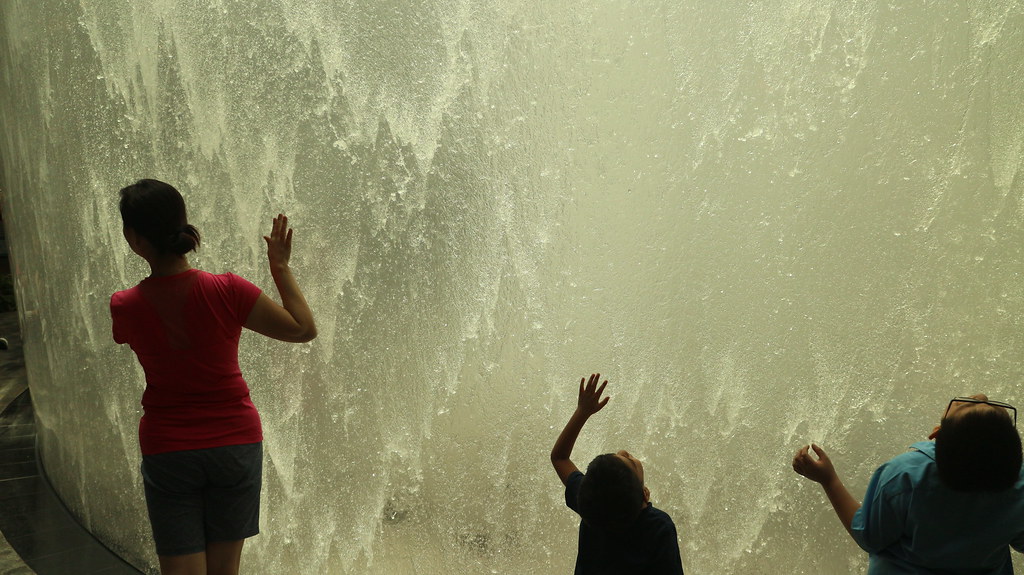27 May 2019
The Rain Vortex: The World’s Largest Indoor Waterfall
You have to hand it to the Singaporeans; they don’t do things in half-measures. April saw the opening of The Rain Vortex in the island’s Changi Airport. It’s a stunning piece of architecture and the newest addition to the airport’s Jewel extension. The world’s largest indoor waterfall has seen a huge upsurge in people going to the airport to fly absolutely nowhere but simply to gawp at this latest man-made marvel.
Image Credit
It’s certainly gawpable. At 40 meters (130 feet) in height, it makes the airport an attraction in itself.
What do you do, after all, when you want to replace your old carpark? Replace it with a waterfall and forest, of course – but don’t forget the retail…
Image Credit
Now, when visitors arrive at the airport, they are greeted with what has been described as a ‘forest valley’. There are over 3,000 trees in the new complex alongside the waterfall – and tucked away discretely are almost 300 shops and restaurants. There is the largest Nike in South Asia, an enormous Shake Shack and for lonesome British travelers, a Marks and Spencers for all the scones and butties they might crave. All of this is encased in a 10 storey high glass and metal frame covering 137,000 square meters.
Image Credit
It looks like a newly imagined set for a remake of Logan’s Run; all you need is Farrah Fawcett to pop out from behind a palm tree, suggesting a visit to the New You Shop and the impression would be complete. There’s even a sky train, for goodness’ sake.

The complex took a huge team of consultant architects (from Safdie, RSP and Benoy) over five years to complete. The donut shaped structure with water cascading from a circular atrium to the ground is a radical design; you won’t have seen anything like this before. Then there is the staggering amount of water used. Half a million liters (about 130,000 US gallons) of rain-harvested water is pumped from the roof downwards every day. At peak flow the waterfall accommodates over 10,000 gallons a minute.

The water is collected in tanks at the base of the waterfall. When there is excess rainwater, it is used to irrigate the surrounding trees and shrubs.


There isn’t even any fear of getting slightly wet; the waterfall is shielded by a huge glass cylinder so there is no obligatory soaking involved in getting up close to it.
Image Credit
Image Credit
When night falls, the waterfall and its surrounds are transformed into a 360-degree projected light and sound show.

The airport was opened in 1981 and last year handled almost 66 million passengers. So, although the airport’s attendant parks and man-made forest valleys (not to mention the butterfly park) might do something to offset its carbon footprint it does have some way to go before it can describe itself as carbon neutral. The total cost of the entire project was US$1.25 billion.

The Rain Vortex is certainly a homage to biophilia, but one must wonder at what cost?

Image Credit
First Image Credit
Image Credit
It’s certainly gawpable. At 40 meters (130 feet) in height, it makes the airport an attraction in itself.
What do you do, after all, when you want to replace your old carpark? Replace it with a waterfall and forest, of course – but don’t forget the retail…
Image Credit
Now, when visitors arrive at the airport, they are greeted with what has been described as a ‘forest valley’. There are over 3,000 trees in the new complex alongside the waterfall – and tucked away discretely are almost 300 shops and restaurants. There is the largest Nike in South Asia, an enormous Shake Shack and for lonesome British travelers, a Marks and Spencers for all the scones and butties they might crave. All of this is encased in a 10 storey high glass and metal frame covering 137,000 square meters.
Image Credit
It looks like a newly imagined set for a remake of Logan’s Run; all you need is Farrah Fawcett to pop out from behind a palm tree, suggesting a visit to the New You Shop and the impression would be complete. There’s even a sky train, for goodness’ sake.

The complex took a huge team of consultant architects (from Safdie, RSP and Benoy) over five years to complete. The donut shaped structure with water cascading from a circular atrium to the ground is a radical design; you won’t have seen anything like this before. Then there is the staggering amount of water used. Half a million liters (about 130,000 US gallons) of rain-harvested water is pumped from the roof downwards every day. At peak flow the waterfall accommodates over 10,000 gallons a minute.

The water is collected in tanks at the base of the waterfall. When there is excess rainwater, it is used to irrigate the surrounding trees and shrubs.


There isn’t even any fear of getting slightly wet; the waterfall is shielded by a huge glass cylinder so there is no obligatory soaking involved in getting up close to it.
Image Credit
Image Credit
When night falls, the waterfall and its surrounds are transformed into a 360-degree projected light and sound show.

The airport was opened in 1981 and last year handled almost 66 million passengers. So, although the airport’s attendant parks and man-made forest valleys (not to mention the butterfly park) might do something to offset its carbon footprint it does have some way to go before it can describe itself as carbon neutral. The total cost of the entire project was US$1.25 billion.

The Rain Vortex is certainly a homage to biophilia, but one must wonder at what cost?

Image Credit
First Image Credit

















